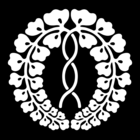Kujō family (Japanese: 九条家, Hepburn: Kujō-ke) is a Japanese aristocratic kin group.[1] The family is a branch of Hokke and,[2] by extension, a main branch of the Fujiwara clan.[3]
| Kujō 九条 | |
|---|---|
 The emblem (mon) of the Kujō clan | |
| Parent house | Fujiwara clan (Hokke) |
| Titles | Various |
| Founder | Kujō Michiie |
| Founding year | 13th century |
| Dissolution | extant |
| Cadet branches | |
History edit
The family claims descent from Fujiwara no Kanezane, third son of Fujiwara no Tadamichi.[4] After the fall of the Taira clan in 1185, Kanezane became Sesshō and Kampaku with the support from Minamoto no Yoritomo;[5] Kanezane then founded an independent family as of 1191,[6] and the family name Kujō was named after a residence located on the road "Kujō-Ōji" (九条大路), where his family lived, built by his ancestor, Fujiwara no Mototsune.[7] Since then, the Kujō became one of the five Fujiwara families from which the Sesshō and Kampaku could be chosen, later known as the five regent houses.[1] The fourth and fifth shōgun' of the Kamakura shogunate, Kujō Yoritsune and Kujō Yoritsugu, came from this family as well.[8]
After the Meiji Restoration, members of the Kujō clan were elevated to princedom and given the title Prince.
Family Tree edit
| adoption | |||||||||||||||||||||||||||||||||||||||||||||||||||||||||
| Fujiwara no Tadamichi (1097-1164) | |||||||||||||||||||||||||||||||||||||||||||||||||||||||||
| Konoe family | |||||||||||||||||||||||||||||||||||||||||||||||||||||||||
| Konoe Motozane (1143-1166) | Kanezane(1) (1149-1207) | ||||||||||||||||||||||||||||||||||||||||||||||||||||||||
| Yoshitsune(2) (1169-1206) | |||||||||||||||||||||||||||||||||||||||||||||||||||||||||
| Michiie(3) (1193-1252) | |||||||||||||||||||||||||||||||||||||||||||||||||||||||||
| Nijō family | Ichijō family | ||||||||||||||||||||||||||||||||||||||||||||||||||||||||
| Norizane(4) (1211-1235) | Nijō Yoshizane (1216-1271) | Ichijō Sanetsune (1223-1284) | |||||||||||||||||||||||||||||||||||||||||||||||||||||||
| Tadaie(5) (1229-1275) | |||||||||||||||||||||||||||||||||||||||||||||||||||||||||
| Tadanori(6) (1248-1332) | Nijō Kanemoto (1267-1334) | ||||||||||||||||||||||||||||||||||||||||||||||||||||||||
| Moronori(7) (1273-1320) | |||||||||||||||||||||||||||||||||||||||||||||||||||||||||
| Fusazane(8) (1290-1327) | Nijō Michihira (1287-1335) | ||||||||||||||||||||||||||||||||||||||||||||||||||||||||
| Michinori(9) (1315-1349) | Nijō Yoshimoto (1320-1388) | ||||||||||||||||||||||||||||||||||||||||||||||||||||||||
| Nijō Morotsugu (1356-1400) | Tsunenori(10) (1331-1400) | ||||||||||||||||||||||||||||||||||||||||||||||||||||||||
| Nijō Mochimoto (1390-1445) | Tadamoto(11) (1345-1398) | ||||||||||||||||||||||||||||||||||||||||||||||||||||||||
| Nijō Mochimichi (1416-1493) | Mitsuie(12) (1394-1449) | ||||||||||||||||||||||||||||||||||||||||||||||||||||||||
| Nijō Masatsugu (1443-1480) | Masatada(13) (1440-1488) | Masamoto(14) (1445-1516) | |||||||||||||||||||||||||||||||||||||||||||||||||||||||
| Nijō Hisamoto (1471-1497) | Hisatsune(15) (1469-1530) | ||||||||||||||||||||||||||||||||||||||||||||||||||||||||
| Nijō Tadafusa (1496-1551) | Tsuneko | Tanemichi(16) (1507-1594) | |||||||||||||||||||||||||||||||||||||||||||||||||||||||
| Nijō Haruyoshi (1526-1579) | |||||||||||||||||||||||||||||||||||||||||||||||||||||||||
| Kanetaka(17) (1553-1636) | Takatsukasa Nobufusa (1565-1658) | ||||||||||||||||||||||||||||||||||||||||||||||||||||||||
| Yukiie(18) (1586-1665) | Takatsukasa Nobuhisa (1590-1621) | ||||||||||||||||||||||||||||||||||||||||||||||||||||||||
| Michifusa(19) (1609-1647) | Takatsukasa Norihira (1609-1668) | ||||||||||||||||||||||||||||||||||||||||||||||||||||||||
| Tokihime (d. 1669)[9] | Kaneharu(20) (1641-1677) | ||||||||||||||||||||||||||||||||||||||||||||||||||||||||
| Sukezane(21) (1669-1730) | |||||||||||||||||||||||||||||||||||||||||||||||||||||||||
| Morotaka(22) (1688-1713) | |||||||||||||||||||||||||||||||||||||||||||||||||||||||||
| Yukinori(23) (1700-1728) | |||||||||||||||||||||||||||||||||||||||||||||||||||||||||
| Tanemoto(24) (1725-1743) | Nijō Munemoto (1727-1754) | ||||||||||||||||||||||||||||||||||||||||||||||||||||||||
| Naozane(25) (1717-1787) | |||||||||||||||||||||||||||||||||||||||||||||||||||||||||
| Nijō Harutaka (1754-1826) | Michisaki(26) (1746–1770) | ||||||||||||||||||||||||||||||||||||||||||||||||||||||||
| Sukeie(27) (1769–1785) | |||||||||||||||||||||||||||||||||||||||||||||||||||||||||
| Suketsugu(28) (1784–1807) | |||||||||||||||||||||||||||||||||||||||||||||||||||||||||
| Hisatada(29) (1798-1871) | Takatsukasa Masamichi (1789-1868) | ||||||||||||||||||||||||||||||||||||||||||||||||||||||||
| Yukitsune(30) (1823-1859) | |||||||||||||||||||||||||||||||||||||||||||||||||||||||||
| Michitaka(31) (1839-1906) | Matsuzono Hisayoshi (1840-1903) | Tsurudono Tadayoshi (1853-1895) | |||||||||||||||||||||||||||||||||||||||||||||||||||||||
| Michizane(32) (1870-1933) | Tsurudono family | ||||||||||||||||||||||||||||||||||||||||||||||||||||||||
| Michihide(33) (1895-1961) | |||||||||||||||||||||||||||||||||||||||||||||||||||||||||
| Michihiro(34) (1933-2017) | |||||||||||||||||||||||||||||||||||||||||||||||||||||||||
| Michinari(35) (b. 1968) | |||||||||||||||||||||||||||||||||||||||||||||||||||||||||
Tsurudono family edit
The Tsurudono family (鶴殿家, Tsudono-ke) was founded by the fifth son of Kujō Hisatada, Tsurudono Tadayoshi (1853-1895), in 1888. The kanji used in the family name was originally "靏殿" but later changed to "鶴殿", both names are pronounced "Tsurudono".[11][12]
See also edit
References edit
- ^ a b Papinot, Jacques Edmond Joseph. (1906). Dictionnaire d’histoire et de géographie du Japon; Papinot, (2003). "Konoe," Nobiliare du Japon, p. 24; retrieved 2013-8-13.
- ^ Amimoto, Mitsuyoshi (2014-07-01). カラー版 イチから知りたい! 家紋と名字. SEITOSHA. pp. 12–13. ISBN 978-4791623075.
- ^ Nussbaum, Louis-Frédéric. (2005). "Go-sekke" in Japan Encyclopedia, p. 260.
- ^ Ueda, Kazutoshi; Mikami, Sanji (1934). 『姓氏家系大辞典』第2巻. pp. 2081–2084. Retrieved 12 October 2019.
- ^ Amimoto, Mitsuyoshi (2014-07-10). カラー版 イチから知りたい! 家紋と名字. 西東社 (SEITOSHA). pp. 13, 28. ISBN 9784791623075.
- ^ Niwa, Motoji (1981). 姓氏の語源. KADOKAWA. p. 57. ISBN 978-4040614007.
- ^ Saeki, Umetomo; Mabuchi, Kazuo (1969). 講談社古語辞典. 講談社. p. 300.
- ^ Morrell, Robert E. (2002-01-01). Early Kamakura Buddhism: A Minority Report. Asian Humanities Press. pp. 23, 37. ISBN 978-0895818508.
- ^ "藤原氏家系 -九條家". 花筐館. Retrieved 2 October 2019.
- ^ "九条(九條)家(摂家)". Archived from the original on 27 April 2019. Retrieved 2 October 2019.
{{cite web}}: CS1 maint: bot: original URL status unknown (link) - ^ a b c 『平成新修旧華族家系大成』下巻. Kasumi Kaikan. 1996. p. 120. ISBN 978-4642036719.
- ^ 大植, 四郎 (1971). 明治過去帳―物故人名辞典. Tokyo Bijutsu. ISBN 978-4808701192.
- ^ "官報. 1889年12月19日". 国立国会図書館デジタルコレクション. Retrieved 12 October 2019.
- ^ 杉, 謙二 (2011). 華族畫報 上. 吉川弘文館. p. 310. ISBN 9784642038065.
- ^ "官報. 1895年04月06日". 国立国会図書館デジタルコレクション. Retrieved 12 October 2019.
- ^ "鶴殿家". Archived from the original on 27 April 2016. Retrieved 12 October 2019.
{{cite web}}: CS1 maint: bot: original URL status unknown (link)